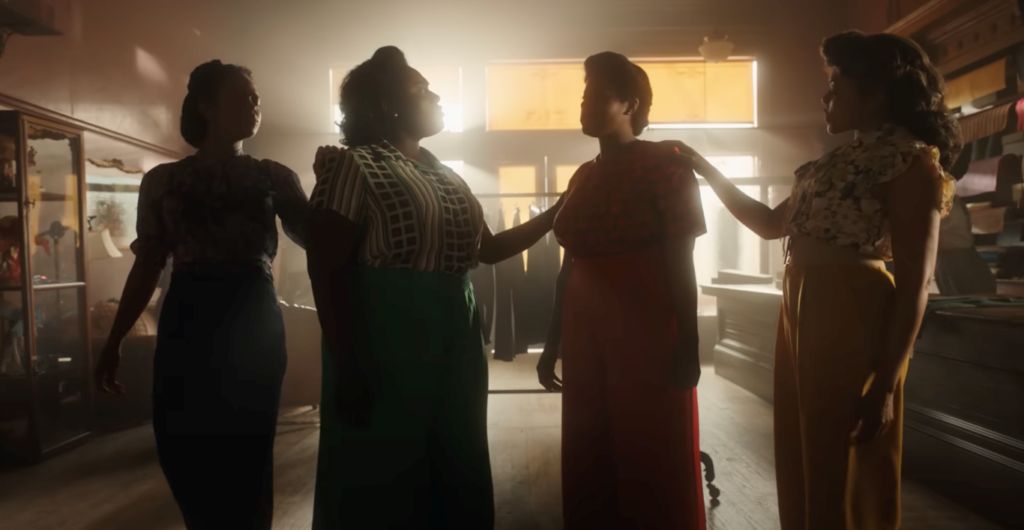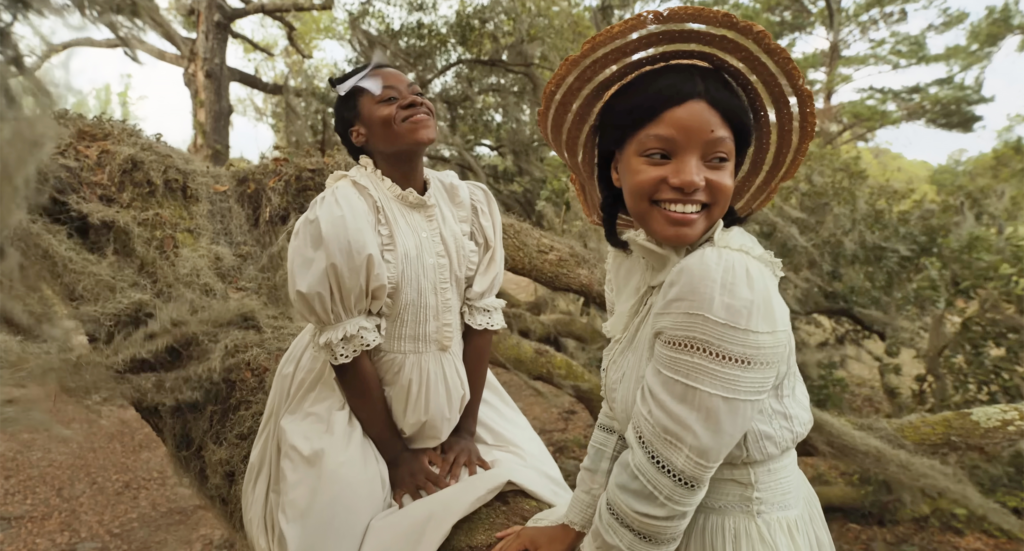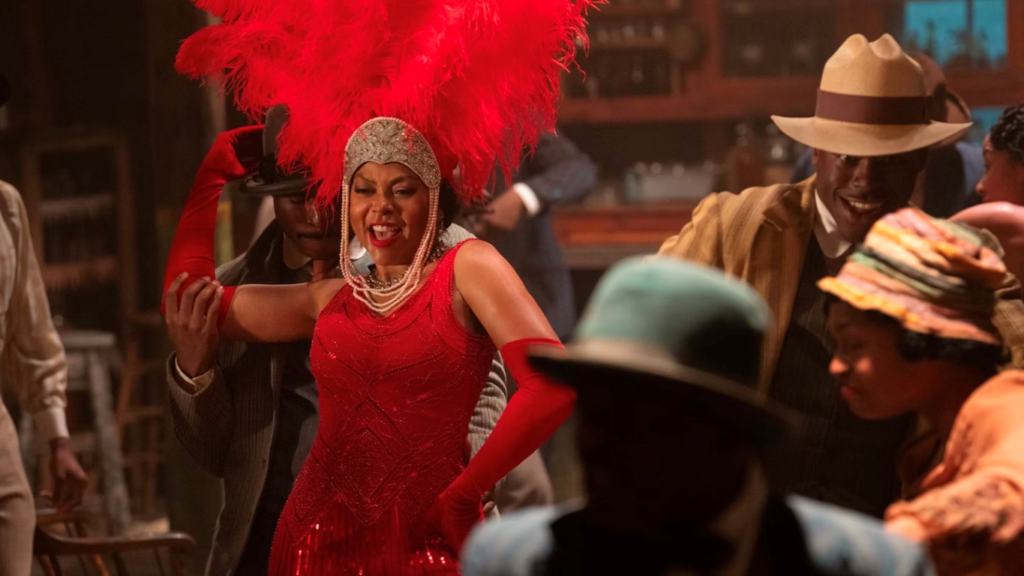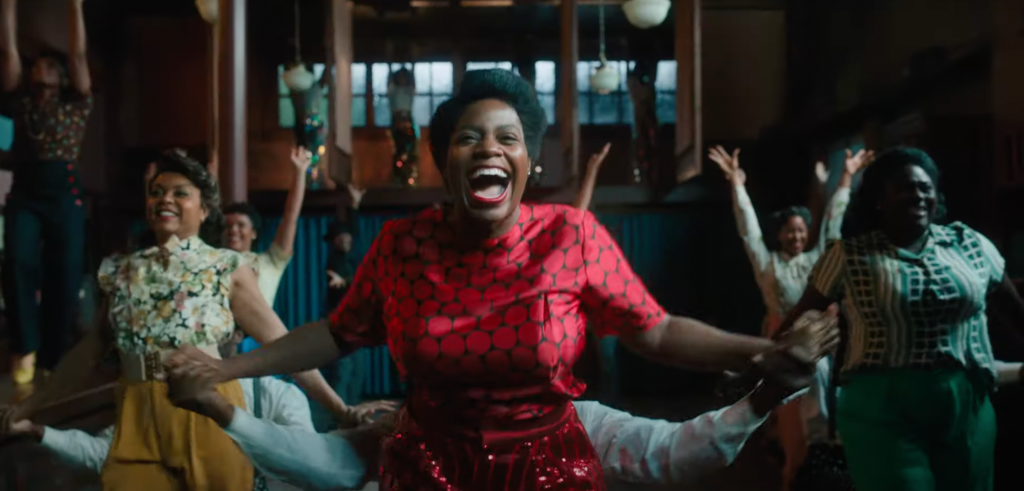Blitz Bazawule’s adaptation of the Alice Walker classic (and the Broadway musical) is a more joyful, celebratory film than its predecessor.
The Color Purple has taken on a musicality ever since Steven Spielberg and Quincy Jones adapted Alice Walker’s 1983 Pulitzer Prize-winning novel for the screen. When the first film was released in 1985, Spielberg already referred to it as a “musical.” In a behind-the-scenes interview about the film’s musicality included in Warner Bros’ sumptuous new 4K release, Walker, Spielberg, and Jones conduct us through the “diverse places” that music appears in the original film. There are rail work songs, African dance, juke joint blues, and revival gospel; all tonally matched together in a near seamless “immersion” of sound.
In an age where nearly every popular and cult film gets a Broadway adaptation, The Color Purple is a particular no-brainer. Celie’s journey of self-discovery through systematic abuses and struggles at the turn of the twentieth century lends itself to the kind of emotional bigness a musical requires. With music by the legendary Brenda Russell and the late queer songwriting icon Allee Willis, The Color Purple: The Musical also showcases a diverse range of musical styles and modes, especially those well suited for the stage, like swing and Greek chorus.
When it opened in 2005, critics praised the performances but struggled with the show’s pacing and shy queerness. Of the show’s eleven Tony nominations, only LaChanze went home with an award for her performance as Celie. Still, the show had a moderately successful run, lasting just long enough for American Idol season three winner (and R&B butterfly) Fantasia Barrino to make an acclaimed Broadway debut when she took over the lead role.
The musical’s 2015 revival in 2015 would have more success. After a few alterations, the pacing felt more tailored. The production won a Tony for Best Revival while Cynthia Erivo won for turn as Celie. Her fellow cast members received applause for their Broadway debuts, including American Idol season 3 contestant and R&B powerhouse Jennifer Hudson’s turn as Shug Avery and Orange is the New Black star Danielle Brooks’ rousing performance as Sofia.

The new film adaptation of the musical directed by Blitz Bazawule (The Burial of Kojo, Black is King) reconvenes many of these astounding talents to tell a new version of The Celiead. The plot is more or less similar to Spielberg’s movie and the Broadway show, which take considerable liberties from the source novel. Young Celie (Phylicia Pearl Mpasi) and her sister Nettie (Halle Bailey) live on the coast of Georgia in the early 1900s. Though still a child herself, Celie has two children by the man she knows as her father. When a leering banjo player named Mister (Colman Domingo) comes courting Nettie to be his new wife, Celie is sold to him instead. Forced to cook and clean up after his unruly throng of children, Celie endures all kinds of violence from Mister. But what hurts the most is how he rips the sisters apart.
Years go by, and Celie (Barrino) is a hollow shell of a human being with the world on her back. Her only solace and company is Ms. Sofia (Brooks), the wife of Mister’s oldest boy, Harpo (Corey Hawkins). Things change when Mister’s old flame, Shug Avery (Taraji P. Henson), blows into town. Shug’s love and zest for life sets Celie on a journey that will lead her to her place in the world. And though the community is tested by racial violence and heartbreak, they find hope in togetherness and see the world differently in each other.
Barrino’s Celie is mild-spoken until a song takes over and then she cascades and flutters over notes like warm butter. Her vocal improvisations reveal Celie’s vulnerability. Her life mirrors the singer’s brilliant vocal runs — wavering, full of flats and sharps on a journey toward serene harmony. She’s delicate and gentle, but Barrino turns that fragility into strength. Celie’s kindness fortifies her, and when she finally turns it inward, it nourishes her roots, and she finds her footing.
Though Barrino is the force that drives the story, Brooks punctuates it with her captivating performance. Brusque and full of brio, she becomes a spirit of rebellion and voice of resistance. Her Sofia sparks like two rocks colliding, grounded and forceful, bowling over anyone who tries to beat her.

Though he may not have starred in the stage musical, Colman Domingo holds his own against these two centers of gravity. (It’s worth noting that he has Broadway chops as well, famous for Passing Strange (2008) and The Scottsboro Boys (2011)). Unlike Danny Glover’s 1985 performance as Mister in Spielberg’s film, Domingo’s character sneers and spits, more wicked than a brute. There’s a snide gravel to his voice which makes him eminently hateable, though it softens as Mister becomes “Albert.”
Yet through this mist of Broadway talent cuts the one, the only, Taraji P. Henson. Fanning herself with feathers that match her breaded crimson dress, she’s here to jazz up the whole town, no matter how Pa the preacher (David Alan Grier) might protest. She does so much with the most challenging character arc of the leading women because so much of it happens off-screen. Henson’s sense of humor pops when needed, while her sentimentality knows how to slow things down just right to fit the rhythm of her scenes with Celie. Their romance is believable in part because Henson is radically receptive and giving as an actress. She’s so sexy and loveable that it’s easy to see why everyone’s attracted to her.
If the Broadway musical shied away from the implicit queerness of the story, Bazawule’s version brings it out of the closet. This Celie develops a keen fascination with Shug before she ever arrives. Their kiss is private and public, occurring within a movie world and movie theater. And there’s definitely a morning after. This openness may seem too contemporary, but as celebrated feminist scholar Saidiya Hartman writes in her book Wayward Lives, Beautiful Girls, many Black women during Celie’s time were forming similar nebulously defined intimate relationships for various reasons outside of what we might now call “sexual orientation.” Celie’s love for Shug is borne not out of a desire for women specifically. She craves tenderness and sisterhood.

Where Spielberg’s vision was an overwrought melodrama where salvation and righteousness only come through intense suffering, Bazawule’s is more compassionate. His approach accepts the difficulties of Black life in the early twentieth century but shows how connection helps the community weather those storms. His retelling minimizes the abuse and centers on resilience. It’s a kinder film. Celie is less “ugly.” Her mother (Aunjanue Ellis) taught her how to read while Nettie taught her geography, making her curious about the world around her in a way Whoopi Goldberg’s version wasn’t allowed to be. She’s beaten down, but that is not her story. Her songs let us into her private thoughts, helping her feel like a human instead of a punching bag who suddenly comes to life.
Sofia’s journey is less brutal as well; she’s less shaken by Harpo’s abuse, not just because she packs a mean punch, but because she has a chorus of sisters for support. Her song of defiance, “Hell No,” is a driving, determined contrast to Oprah Winfrey’s shaken, teary performance in 19895. Even Mister gets more pity in this retelling. Though cursed, he gets his redemption. He even walks away from the film with a shiny new pair of Miss Celie’s pants.
The Color Purple would be a difficult show for any costume designer to handle, juggling many decades and continents the story traverses. Yet, Francine Jamison-Tanchuck perfectly places darts and details to embrace the wearer’s body, no matter the visual style of the scene. As Celie discovers her passion for clothesmaking, Tanchuck and her team work overtime to ensure each of her pieces is immaculate.
It’s a less “rotten” world. Bazawule has replaced Spielberg’s dry, dusty, weathered look for a wet, varied, and vibrant landscape, courtesy of Dan Laustsen’s honeyed cinematography. The musical sequences burst with visual vibrancy, from intimate close-ups to craning chorus numbers. Just as Bazawule leans into his cast’s Broadway experiences, Laustsen lets Celie address the camera like a performer would address an audience from center stage. At the same time, the brilliantly executed dream sequences add a welcome meta-cinematic touch that offers abstract and interior perspectives that theater often cannot.

This brightly-colored optimism, coupled with the openness and theatricality of the performances, makes this new version of The Color Purple come off a bit broad at times. For folks expecting Spielberg’s dourness, this adaptation may feel insincere (though we shouldn’t confuse “theatrical” with “superficial”). It’s a lighter-hearted film of immense emotion and grand gestures, but underneath is a profound reorientation from how white directors have told stories of historical Black life.
While answering criticisms of the original film and Broadway production, Bazawule shifts our gaze from the individual towards a greater sense of community. Emphasizing the Reconstruction era emergence of Black capitalism allows the characters to exist in an almost entirely Black world. The Mayor’s Wife (Elizabeth Marvel) still makes her diabolical appearance, but their daily lives are less interrupted by white people than Spielberg’s version would have us suppose.
Thanks to its toe-tapping chorus numbers and tender duets, this new adaptation has a refreshing focus on community and the bonds we share. More than any other film or musical version, Bazawule’s film addresses us directly and compels us to notice and be thankful for the color purple in everyone and everything.
The Color Purple dances into cinemas on Christmas Day.
The Color Purple Trailer:
Read next: The Spool's Best New Releases
Streaming guides
The Best Live TV Streaming Services With Free Trial
The praises of live TV streaming services don’t need to be further sung. By now, we all know that compared to clunky, commitment-heavy cable, live TV is cheaper and much easier to manage. But just in case you’re still on the fence about jumping over to the other side, or if you’re just unhappy with ... The Best Live TV Streaming Services With Free Trial
How to Watch Power Book III: Raising Kanan Season 3
Season 3 of the hotly anticipated Power spin-off, Power Book III: Raising Kanan, is arriving on Starz soon, so you know what that means: it’s the ’90s again in The Southside, and we’re back with the Thomas family as they navigate the ins and outs of the criminal underworld they’re helping build. Mekai Curtis is ... How to Watch Power Book III: Raising Kanan Season 3
How to Watch Doctor Who: 60th Anniversary Specials
Ladies and gentlemen, we’re so back! To celebrate Doctor Who’s 60th anniversary, the BBC is producing a three-episode special starring none other than the Tenth/Fourteenth Doctor himself, David Tennant. And to the supreme delight of fans (that would be me, dear reader), the Doctor will be joined by old-time companion Donna Noble (Catherine Tate) and ... How to Watch Doctor Who: 60th Anniversary Specials
Which Netflix Country has Interstellar?
Maybe you’ve just seen Oppenheimer and have the strongest urge to marathon—or more fun yet, rank!—all of Christopher Nolan’s films. Or maybe you’re one of the few who haven’t seen Interstellar yet. If you are, then you should change that immediately; the dystopian epic is one of Nolan’s best, and with that incredible twist in ... Which Netflix Country has Interstellar?
Which Netflix Country Has Each Movie of The Hunger Games?
For whatever reason, The Hunger Games series isn’t available in the same countries around the world. You’ll find the first and second (aka the best) installments in Hong Kong, for instance, but not the third and fourth. It’s a frustrating dilemma, especially if you don’t even have a single entry in your region, which is ... Which Netflix Country Has Each Movie of The Hunger Games?
How to Watch ESPN With A Free Trial
One of the major concerns people have before cutting the cord is potentially losing access to live sports. But the great thing about live TV streaming services is that you never lose that access. Minus the contracts and complications of cable, these streaming services connect you to a host of live channels, including ESPN. So ... How to Watch ESPN With A Free Trial
How to Watch Paramount Network With a Free Trial
To date, Paramount Network has only two original shows on air right now: Yellowstone and Bar Rescue. The network seems to have its hands full with on-demand streaming service Paramount+, which is constantly stacked with a fresh supply of new shows. But Yellowstone and Bar Rescue are so sturdy and expansive that the network doesn’t ... How to Watch Paramount Network With a Free Trial
How to Watch WE TV With a Free Trial
Previously “Women’s Entertainment,” We TV has since rebranded to accurately reflect its name and be a more inclusive lifestyle channel. It’s home to addictive reality gems like Bold and Bougie, Bridezillas, Marriage Boot Camp, and The Untold Stories of Hip Hop. And when it’s not airing original titles, it has on syndicated shows like 9-1-1, ... How to Watch WE TV With a Free Trial
How to Watch TNT Sports With A Free Trial
For many sports fans, TNT is a non-negotiable. It broadcasts NBA, MLB, NHL, college basketball, and All Elite Wrestling matches. And, as a bonus, it also has reruns of shows like Supernatural, Charmed, and NCIS, as well as films like The Avengers, Dune, and Justice League. But while TNT used to be a cable staple, ... How to Watch TNT Sports With A Free Trial
How to Watch Comedy Central With a Free Trial
It’s no coincidence that many of today’s biggest comedians found their footing on Comedy Central: the channel is a bastion of emerging comic talents. It served as a playground for people like Nathan Fielder (Fielder For You), Ilana Glazer and Abbi Jacobson (Broad City), Tim Robinson (Detroiters), and Dave Chappelle (Chappelle’s Show) before they shot ... How to Watch Comedy Central With a Free Trial
How to Watch FX With a Free Trial
You’d be hard-pressed to find a bad show airing on FX. The channel has made a name for itself as a bastion of high-brow TV, along with HBO and AMC. It’s produced shows like Atlanta, Fargo, The Americans, Archer, and more recently, Shogun. But because it’s owned by Disney, it still airs several blockbusters in ... How to Watch FX With a Free Trial